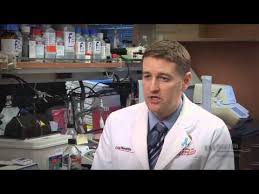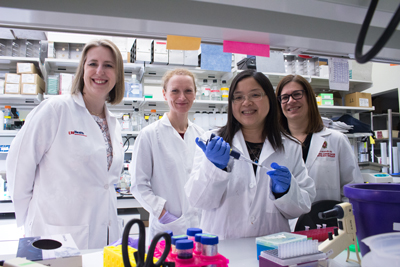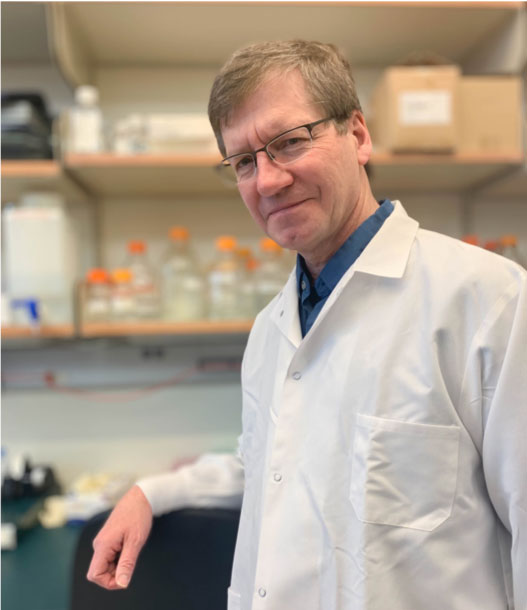The More for Stage IV Research Fund at the

Metastatic breast cancer (MBC, also known as Stage IV) is breast cancer that has spread beyond the breast to other organs in the body. No one dies from cancer in the breast; deaths are due to metastasis to other parts of the body. Once breast cancer has metastasized it is a terminal disease – THERE IS NO CURE.
For decades, funding has focused on prevention, awareness, and early detection. Unfortunately, early detection and subsequent treatments do not guarantee a cure. Metastatic breast cancer can occur five, ten or many years after a person’s original diagnosis. Less than 10 percent of all breast cancer research dollars goes towards Stage IV. Despite all the emphasis on breast cancer, there has been no significant reductions in annual deaths from MBC. The More for Stage IV fund was established in December 2016 at the University of Wisconsin Carbone Cancer Center. (UWCCC) and has now raised over $2,300,000! Its mission is to encourage innovative research at the UWCCC and is specifically related to metastatic breast cancer and supports the following pilot projects.
Defining the patient-specific molecular pathways underlying long term survival in metastatic breast cancer.
Sushmita Roy, PHD, and Mark Burkard, MD, PHD,
Most patients diagnosed with metastatic breast cancer (MBC) have poor survival. Remarkably, a few individuals, called long-term survivors, are able to survive much longer than expected. Genome sequencing of tumor DNA have identified specific changes (mutations) in the DNA that are associated with an individual’s susceptibility to get cancer. Furthermore, such mutations have been shown to disrupt underlying molecular networks that control a living cell’s core process and function.
The overall goal of their proposal is to develop and apply computational tools to identify and characterize the mutations and underlying molecular networks that are specific to long-term survivors of MBC compared to other patient cohorts. Successful completion of the project will predict candidate molecular pathways that could be therapeutically targeted for improving survival and patient care of metastatic breast cancer patients.
Bispecific Nanocarriers for Synergistic Effect of Immuno- and Chemo-therapies.
Seungpyo Hong, PhD and Deric Wheeler, PhD
They aim to develop a novel nanoscale delivery platform that enables co-delivery of immuno- and chemo-therapeutic agents by bi-specifically targeting EGFR- and PD-L1-overexpresing TNBC cells, which may in turn substantially improve the therapeutic outcome of MBC. The modularity of the proposed multifunctional nanocarrier system would help not only TNBC patients but patients with various types of cancer and other disease types as well, such as auto-immune diseases, by incorporating various targeting and therapeutic molecules into the platform.
Additionally, the low cost of peptides would allow to offer more affordable, personalized options for patients.
Use of fulvestrant to enhance immunotherapy response of metastatic breast cancer in obesity
Lisa M. Arendt, PhD
 The development of a class of drugs called immune checkpoint inhibitors have significantly improved survival outcomes for patients diagnosed with multiple types of tumors. This therapy targets an immune cell population called CD8+ T cells. Within metastases, CD8+ T cells function poorly, and immune checkpoint inhibitors act to activate CD8+ T cells to improve their ability to kill cancer cells. These drugs are clinically used to treat metastatic triple negative breast cancer; however, the response rates are low. One potential reason that immune checkpoint inhibitors do not work well is that other types of immune cells, including macrophages, limit their function. Macrophages normally act to stimulate CD8+ T cells. However, in breast cancer metastases, macrophages send out signals to CD8+ T cells to keep them away from the metastases. Developing treatment strategies that alter the signals that macrophages produce could increase the ability of CD8+ T cells to interact with metastatic tumor cells and kill them. Obesity increases the number of macrophages in metastases, and strategies that change macrophage function could be beneficial for obese stage IV breast cancer patients.
The development of a class of drugs called immune checkpoint inhibitors have significantly improved survival outcomes for patients diagnosed with multiple types of tumors. This therapy targets an immune cell population called CD8+ T cells. Within metastases, CD8+ T cells function poorly, and immune checkpoint inhibitors act to activate CD8+ T cells to improve their ability to kill cancer cells. These drugs are clinically used to treat metastatic triple negative breast cancer; however, the response rates are low. One potential reason that immune checkpoint inhibitors do not work well is that other types of immune cells, including macrophages, limit their function. Macrophages normally act to stimulate CD8+ T cells. However, in breast cancer metastases, macrophages send out signals to CD8+ T cells to keep them away from the metastases. Developing treatment strategies that alter the signals that macrophages produce could increase the ability of CD8+ T cells to interact with metastatic tumor cells and kill them. Obesity increases the number of macrophages in metastases, and strategies that change macrophage function could be beneficial for obese stage IV breast cancer patients.
We will test the hypothesis that the use of fulvestrant in combination with immune checkpoint inhibitors will reduce ER- metastasis under conditions of obesity through increased activity of CD8+ T cells and reduced macrophages that limit CD8+ T cell function. The combination of fulvestrant and immune checkpoint inhibitors have been used in combination in clinical trials examining their effect to limit early-stage ER+ breast cancer. These drugs are clinically safe with limited side effects. Successful completion of our studies could lead to rapid translation of this new drug combination into clinics for treatment of patients with metastatic triple negative breast cancer. This could lead to improved treatments for obese patients with stage IV breast cancer who currently have limited treatment options. New understanding of immunotherapy responses could also improve the selection of drugs for patients with stage IV breast cancer to identify patients that are mostly likely to benefit from immunotherapy treatments.
What can be done after breast cancer becomes anti-estrogen therapy-resistant?
The majority of metastatic breast cancers are estrogen receptor (ER)-positive. Cancers that express this receptor are stimulated to grow in the presence of the hormone, estrogen. Thus, various anti-estrogens are used for the treatment of ER-positive metastatic breast cancers. However, over time, these cancers develop resistance to anti-estrogen therapies. One way this resistance happens is when the cells mutate their ER into forms that both no longer bind the drug and are “always on” (signal the cell to grow even in the absence of any estrogen). At this point, treatment options are much more limited.
Joshua Lang, MD, MS
-
New treatments for cancer are increasingly aimed at targeting specific mutations. As such, a medication known as alpelisib (Piqray) was approved by the FDA in 2019 for patients with metastatic hormone receptor positive breast cancers that carry the DNA mutations that activate PI3K proteins. However, the drug is only effective in just over half of patients whose tumors have these mutations currently there is no easy way of identifying which patients will benefit from this medication.
The Lang lab is developing an assay, or a biological test, to change that. Lang’s technology focuses on isolating and testing so-called “circulating tumor cells” in a patient’s blood stream. These cells, shed by a patient’s tumor, can be collected through a non-invasive blood draw and monitored over time. By measuring the activity level of PI3K proteins in circulating tumor cells, this method will allow Oncologists to monitor whether drugs like alpelisib are effectively inhibiting these proteins in circulating tumor cells early after starting treatment. We hope that this will allow doctors to predict early on which patients will benefit from alpelisib and which patients should receive a different treatment.

Wei Xu, PhD:
- The Xu laboratory has discovered that a potential drug, called DipG, which can overcome resistance to hormone-positive breast cancer and is a potential new anti-estrogen drug that was discovered in a screen of plant natural products as having strong ER-degrading properties. In contrast to current drugs, Dip G binds to a protein that regulates ER stability, meaning it should work even after cancers develop resistance to current therapies.
- In fact this is what Xu’s group saw when they tested Dip G on otherwise resistant breast cancer cells in the lab. Currently, her group is comparing Dip G to other ER-degrading drugs and working to improve its pharmaceutical properties.
Heidi Dvinge, PhD
- Anti-estrogen therapy-resistance is not one-size-fits-all, and mutations in ER vary across patients. Dvinge started with genetic data on over 1000 breast cancer patients and is now studying different resistant forms of ERs to find out if the receptor variants make the patients fully or partially resistant to anti-estrogen therapies.
- She expects these variations will be useful as biomarkers to predict patient response. She is also using these resistant forms of ER to find even more drugs that target it when others fail, similar to Dr. Xu’s work with Dip G.

Kari Wisinski, MD and Amy Fowler, MD, PhD
- Some patients may have cancers that are not totally resistant to an anti-estrogen, they just may need higher drug doses to respond – especially if there are mutations in the ER gene. Using a low-dose, radioactively-labeled estrogen called FES, Wisinski and Fowler will use a PET/CT scan to look at increasing tamoxifen dosing. FES and tamoxifen compete for binding ER, so if the scan shows FES is able to bind to tumors, that means the drug dose may be too low and that a higher dose may be more likely to help the patient.
- If they see no FES binding to tumors in the scan, then the tamoxifen dose is optimal. They expect their trial will establish routine testing for ER mutations in metastatic breast cancer patients and will lead to maximizing the benefits of these drug therapies.
How can we quickly monitor changes in metastatic breast cancers and switch treatments accordingly?
For metastatic breast cancer patients, timing is crucial. You want to give the best drug for each patient as soon as possible and not waste time on a drug to which they are unlikely to respond. Biopsies, especially of metastatic sites, are invasive and do not provide a real-time snapshot of the current state of the metastatic cancer’s characteristics.
“Liquid biopsies” are simple blood draws from which cancer cells (circulating tumor cells, or CTCs) of DNA from cancer cells can be isolated and analyzed, essentially in real-time. More for Stage IV is funding these two research projects related to CTCs.
Joshua Lang, MD and Ruth O’Regan, MD
- Lang pioneered CTC research at UW Carbone, starting with metastatic prostate cancer. The androgen hormone receptor (AR) functions similarly to ER in breast cancers, and most of the resistant prostate cancers result from mutations in AR. Lang will continue to develop CTC technology for clinical use and O’Regan will bring her expertise as a breast cancer physician and researcher to move CTC work into breast cancer.
- Using blood samples from patients with metastatic breast cancer, Lang and O’Regan will isolate cancer cells and then analyze changes in DNA and protein levels. They can then monitor when and how the ER and other features of the cancer make it resistant to anti-estrogen therapy. They will also look to match patient samples to current FDA-approved drugs, to see if they can predict patient response to treatment with a particular focus on Taxol chemotherapy.

Can we improve immune-based therapies to treat metastatic breast cancer?
Immunotherapies have revolutionized the treatment of many different types of metastatic cancer. However, they are not approved for metastatic breast cancer because only a small fraction (~15 percent) appear to have a benefit. Most metastatic breast cancers are not highly mutated, so the patient’s immune system sees them as healthy, and not as the threat they really are.
More for Stage IV is funding research that seeks to make breast cancer cells more visible to the immune system, making it more likely that patients will see a benefit from immunotherapies.

Mark Burkard, MD, PhD
- While the DNA of healthy cells is strictly located inside the nucleus, some unhealthy cells, such as a virus-infected cell, have DNA outside the nucleus which acts as a signal to the immune system. Extranuclear DNA is also found in a small number of cancers. Dr. Burkard proposes that extranuclear DNA levels can be increased in cancer cells by a class of drugs, the taxanes.
- Using 354 breast cancer samples, he and his research team will first measure the extranuclear DNA and immune signal levels in breast cancer. After treating the cells with taxanes, they will ask, do the extranuclear DNA levels increase? Do the immune signaling levels increase? If yes to both, then taxanes are likely to work well in combination with immunotherapy treatments to improve patient.
Can limiting cross-talk between cancer cells reduce their ability to spread?
In breast cancer, patient survival is threatened not by the primary tumor, but by the uncontrolled growth of cancer cells that have spread to other organs. However, some cancer cells spread early in cancer formation, often before the tumor is discovered, lying dormant as “time bombs” in distant organs. Not every cancer cell becomes a metastatic site, though, because the environment into which it settles has profound impacts on which outcome it takes.
Dr. Andreas Friedl, Department Chair – Pathology and Laboratory Medicine
-
Our work has honed in on a molecule, Sdc1, that is found at higher levels in the non-cancerous cells within lung metastatic sites than is found in lung tissue that is not associated with cancer. Sdc-1 is critical for producing transport vesicles that move signaling chemicals between cells and allow cells to communicate with one another. Our research suggests Sdc-1 directly promotes those dormant cancer cells to grow. For this project, we will first confirm in several breast cancer cell lines in the lab that Sdc-1 in the local environment is required for cancer growth at the metastatic sites. Next, we will we will attempt to establish which molecular “cargo” in the vesicles is responsible for stimulating metastasis. Ideally, our work will lead to two outcomes: first, to be able to identify potential druggable targets to suppress the growth of the metastases, and second, to be able to measure the metastasis-linked vesicle cargo in patients’ blood samples to predict and monitor metastasis.
How to better treat metastatic triple-positive breast cancer (TPBC) patients
Wei Xu, PhD and Mark Burkard, MD/PhD
Metastatic triple-positive breast cancer (TPBC) are advanced cancers that display elevated levels of the three proteins or ‘receptors’ – estrogen, progesterone and HER2 – that drive breast cancer growth. TPBC has often been treated using HER2-targeted therapies, in conjunction with chemotherapy, but the combination has traditionally not been very effective for this type of cancer.
To improve outcomes, a number of studies have tried omitting chemotherapy in favor of combined endocrine therapy plus anti-HER2-targeted therapy. With this combination, roughly half of patients had either a substantial or complete pathological response to the treatment. However, this also means that the other half had little to no response. Using single-cell RNA sequencing and spatial transcriptomics (a special technology that allows researchers to measure and map gene activity), the Xu and Burkard labs will use frozen TPBC tumor specimens to explore the “crosstalk” between estrogen receptors and HER2 receptors on the cellular level. By doing this, they hope to determine how this cellular signaling contributes to the body’s response to tandem anti-estrogen and HER2-targeted therapy. The results of this research could lead to better predictions for doctors to accurately predict which TPBC cases will react well to this specific treatment.
How can immunotherapy be used in MBC
Immunotherapy – the process of using one’s immune system to help fight cancer – has been a major breakthrough in cancer treatment in recent years. However, prior attempts to treat advanced estrogen receptor-positive (ER+) breast cancer using immunotherapy have not been very effective. Due to a lack of known targets expressed by these types of tumors, ER+ breast cancer is considered immunologically “cold.”
Linda Schuler, PHD.
A new study, led by UW’s Linda Schuler looks to warm things up and set the stage for improved outcomes for patients with ER+ breast cancer. Using an immunocompetent mouse model of spontaneous metastatic ER+ breast cancer, along with new technology, the Schuler lab will profile the immune micro-environments of primary tumors and lung metastases. Understanding these cellular micro-environments is essential to illuminate a path toward use of immunotherapies which will durably control metastatic disease.
The study is expected generate previously unavailable information on ER+ metastatic cancer, and will reveal how the lung environment alters the tumor immune environment compared to the primary breast tumor. It will also demonstrate how complementary therapies, such as anti-estrogen therapy, affect these environments. All of this could and suggest potential targetable pathways for future immunotherapy treatments, which can be tested in future experiments.

How to test drugs in a patent-specific environment
Joshua Lang, MD, MS and David Beebe, UW College of Engineering
-
There is a critical need to understand which treatments will work for the MBC patient. Now, a collaboration between David Beebe, a University of Wisconsin biomedical engineer and Dr. Joshua Lang, a physician-scientist at the UW Carbone Cancer Center have led to the development of an exciting new “tumor-on-a-chip” technology that is uniquely suited to address this challenge.
Using microscale, microfluidic chips, researchers are able to grow tumor cells from a patient biopsy inside an artificially recreated “tumor microenvironment” from the same patient. This approach creates an individualized model of not just a patient’s tumor but also the surrounding cells that support the tumor. This can then be used to test how different drugs work, or don’t work, to kill tumor cells in the patient-specific microenvironment. This technology could also be used to predict which of a set of possible treatments is most likely to be successful in treating that individual patient.
These researchers are seeking to pilot this technology for patients with Stage IV breast cancer being treated with a new medication called IMMU-132, which has recently been approved for treatment-resistant triple negative breast cancer and has shown promising results in hormone receptor-positive metastatic breast cancer. The hope is to create a patient-specific tumors-on-a-chip that will be treated with IMMU-132 and then compare the how the cancer on the chip responds to this drug to judge how each patient benefits from IMMU-132.
Our work has honed in on a molecule, Sdc1, that is found at higher levels in the non-cancerous cells within lung metastatic sites than is found in lung tissue that is not associated with cancer. Sdc-1 is critical for producing transport vesicles that move signaling chemicals between cells and allow cells to communicate with one another. Our research suggests Sdc-1 directly promotes those dormant cancer cells to grow. For this project, we will first confirm in several breast cancer cell lines in the lab that Sdc-1 in the local environment is required for cancer growth at the metastatic sites. Next, we will we will attempt to establish which molecular “cargo” in the vesicles is responsible for stimulating metastasis. Ideally, our work will lead to two outcomes: first, to be able to identify potential druggable targets to suppress the growth of the metastases, and second, to be able to measure the metastasis-linked vesicle cargo in patients’ blood samples to predict and monitor metastasis.

